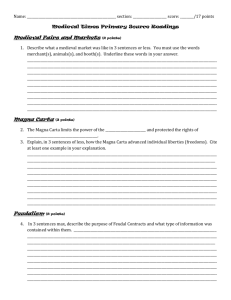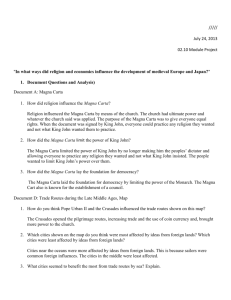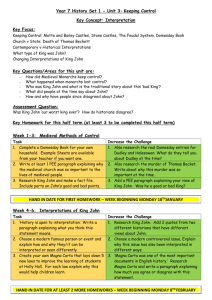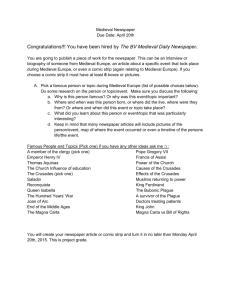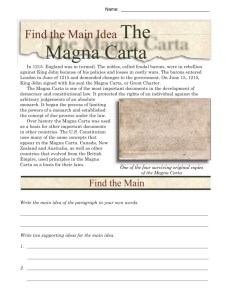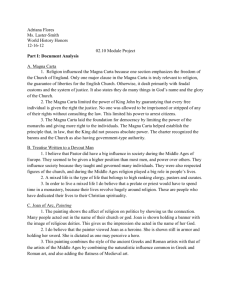"In what ways did religion and economics influence the development
advertisement
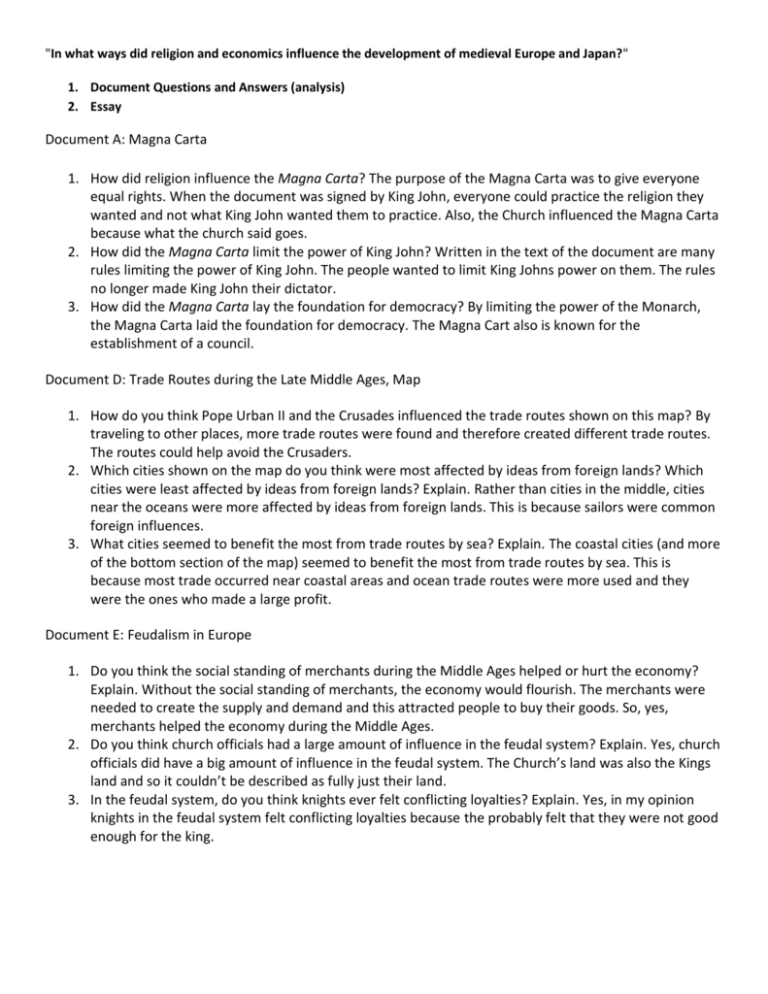
"In what ways did religion and economics influence the development of medieval Europe and Japan?" 1. Document Questions and Answers (analysis) 2. Essay Document A: Magna Carta 1. How did religion influence the Magna Carta? The purpose of the Magna Carta was to give everyone equal rights. When the document was signed by King John, everyone could practice the religion they wanted and not what King John wanted them to practice. Also, the Church influenced the Magna Carta because what the church said goes. 2. How did the Magna Carta limit the power of King John? Written in the text of the document are many rules limiting the power of King John. The people wanted to limit King Johns power on them. The rules no longer made King John their dictator. 3. How did the Magna Carta lay the foundation for democracy? By limiting the power of the Monarch, the Magna Carta laid the foundation for democracy. The Magna Cart also is known for the establishment of a council. Document D: Trade Routes during the Late Middle Ages, Map 1. How do you think Pope Urban II and the Crusades influenced the trade routes shown on this map? By traveling to other places, more trade routes were found and therefore created different trade routes. The routes could help avoid the Crusaders. 2. Which cities shown on the map do you think were most affected by ideas from foreign lands? Which cities were least affected by ideas from foreign lands? Explain. Rather than cities in the middle, cities near the oceans were more affected by ideas from foreign lands. This is because sailors were common foreign influences. 3. What cities seemed to benefit the most from trade routes by sea? Explain. The coastal cities (and more of the bottom section of the map) seemed to benefit the most from trade routes by sea. This is because most trade occurred near coastal areas and ocean trade routes were more used and they were the ones who made a large profit. Document E: Feudalism in Europe 1. Do you think the social standing of merchants during the Middle Ages helped or hurt the economy? Explain. Without the social standing of merchants, the economy would flourish. The merchants were needed to create the supply and demand and this attracted people to buy their goods. So, yes, merchants helped the economy during the Middle Ages. 2. Do you think church officials had a large amount of influence in the feudal system? Explain. Yes, church officials did have a big amount of influence in the feudal system. The Church’s land was also the Kings land and so it couldn’t be described as fully just their land. 3. In the feudal system, do you think knights ever felt conflicting loyalties? Explain. Yes, in my opinion knights in the feudal system felt conflicting loyalties because the probably felt that they were not good enough for the king. Document H: Excerpt for Secondary Source and Topographical Map of Japan 1. Based on this excerpt, do you think trade was instrumental in the spread of Buddhism to Japan? Explain. No, I contemplate that Europeans compelled them or convinced them to trade. 2. Summarize the trade relations described in this excerpt. Do you think the geographic locations of Japan, China, and Korea contributed to this trade? Explain. I think that it did positively affect trade but also, if they weren’t in good geographic locations, they would find other ways to find a good source. 3. Based on the geography of Japan, do you think trade from one area of Japan to another could be difficult? Explain. Yes, because Japan is separated over a large amount of land and restrictions to some areas can hinder trade from one area of Japan to another. "In what ways did religion and economics influence the development of medieval Europe and Japan?" Religion and Economics have affected the progress of Medieval Europe and Japan. How? Well, the interchange of goods or services and the economic structure of both empires came to be the main portion of their success and development. Faith and economics affected the development of Medieval Europe and Japan because faith and tradition were extremely vital in both Medieval Europe and Japan! Religion and Economics both frolic a huge portion in the development of Medieval Europe and Japan. These two things considerably affected the development of Europe and Japan because faith, religion, and tradition was extremely vital to both locations, and trade and economy was a huge portion of success. Faith, belief, and religion was the main cause of conflict across this period of time, encompassing the Crusades, a series of wars that was commenced by Pope Urban the second and involved other important leaders such as Louis IX of France. Before these fights, the church was tremendously affluent and had no separation from politics. In addition, the pope had extra manipulation and power than the king. Religion didn't have as far of a result on daily existence and general progress of Japan as it did for Europe. Later the Japanese discovered Zen, which was an exercise that was especially concentrated on a confidential experience for enlightenment. Additionally, the Japanese learned to make European style muskets after a Portuguese boat appeared at one of their ports which transformed Japanese warfare. Countless people modified their beliefs to Christianity and there was an increase in trade. The Japanese government soon then came to be interested in land. The development of Medieval Europe Feudalism also became present during this time. In the European feudal system, kings had the highest spot in society. With European feudalism, knights and vassals were conceded land from their noble and they would reciprocate by pledging to assist and protect him. Furthermore, this method created the vassal and noble partnership and connection. This relationship could be comparable to the relationship of the shogun and daimyo. In conclusion, there are countless contrasts and similarities amid the progress, success, and development of Medieval Europe and Japan. Faith and Economy, both important to both empires, would be considered the final line and affected the sophistication, combat, and outcome of Medieval Europe and Japan. This has helped the transformation of Medieval Europe and Japan to the modern day Europe and Japan that we understand today.
